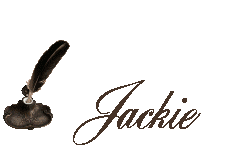   |
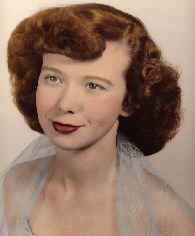 1950 Jacqueline Ann Josey Page 1 of 2    |
   |
   |
 1950 Jacqueline Ann Josey Page 1 of 2    |
   |
 My favorite song is "Camelot," but I have used that on our other web
site, thehouseofjossey-josey.org. So, I am playing my second favorite
song, "My Way." I hope you enjoy it while you spend time on my
page. "My Way," is also apropos in the sense that I have been told that I am
opinionated and tend to do things "My Way."
My favorite song is "Camelot," but I have used that on our other web
site, thehouseofjossey-josey.org. So, I am playing my second favorite
song, "My Way." I hope you enjoy it while you spend time on my
page. "My Way," is also apropos in the sense that I have been told that I am
opinionated and tend to do things "My Way."
This is a perfect background for my family tree graphics at the top, since I am such an avid genealogist. I will go into that at the end of this page. I was born in Louisiana more than 70 years ago, January 10, 1934, on a Wednesday at 3:00 pm, and am the eldest of seven children, five girls and two boys. This photo to the left is the only baby picture that was taken of me, as far as I know, and my adorable Aunt Hazel gave me this picture.
Below are some photos, courtesy of Carole Wood, of the Shreveport, LA Charity Hospital, as it appeared at the time we were all born, in the 1930's and 1940's.
 |
 |
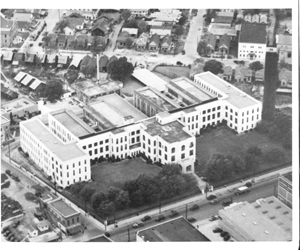 |
I took a short writing class at USF, and one thing we were to write about was on the turning points in our lives. One turning point for me was losing a sister, Wanda Ruth, to leukemia at the age of 2 1/2. Our dad took mechanic jobs wherever they were available and we moved around a lot. Mother stayed home and took care of the children, as most women did in those days. The days of the 30's and 40's and sacrifices that had to be made, really tested one's mettle. With the depression and then WWII, those were definite turning points. It is quite an understatement to say that period ingrained in all of us an attitude that speaks volumes when we say "I am really thankful for what I have today." As stated in Tom Brokaw's "The Greatest Generation," "we lived lives of innocent deprivation in our childhood."
As stated above, our dad was a mechanic by trade and a flight engineer in the Army/Air Corps during WW II. Mother worked in a defense shell plant for a period during WW II. There was an article in the local newspaper (I am pretty sure it was the Shreveport Times or Journal) when our dad was in the service about the PFC with six dependents and how he earned $2,544 a year in the service. Our positions are front - left to right - Jacqueline (Jackie), James (Buddy), behind me is mother holding Patricia (Pat), daddy holding Betty, behind mother is Byron (Bo) and in the center is Evangeline (Angie). Still do not know how Betty never got a nickname.
 |
My fondest memories are of spending the most part of my summers with "Granny Josey" in Vivian, LA. I also have fond memories of going to Texas to spend time in the summers with Uncle Lloyd, Aunt Hazel and Shirley. You can find pictures of all three of them on my mother's 75th birthday page. They were such a beautiful family. You will discover more about "Granny" on her page. Everyone should have a special "Granny" like that in their lives. However, I have enjoyed my visits with Granny's last living daughter-in-law, my Aunt Lessie Josey, who is still living in Vivian, LA. She has shared so many great stories with me when I have visited with her. She is pretty special too. Sad update - We lost Aunt Lessie February 1, 2010. I truly miss her so much.
As children, we visited some other relatives a few times in the summers and more than once we spent all day with a cotton pickin bag draped over our shoulders and dragging the ground. We thought that with a whole day's worth of picking cotton, we were going to be rich. You can imagine our shock when we got one nickel for that entire day's work. Ah, such memories! And, my brother, Buddy, had a paper route in the mid-1940's, and we would get up at 4:00 a.m. to go fold and throw those papers while carrying the long canvas bag over our shoulders, and later getting a bike to deliver the papers on. We loved to play hopscotch, jump rope, jacks, cut out paper dolls, skate with a pair of skates that clamped onto our shoes, played baseball, with a stick and a ball of string rolled up into a ball, kick a tin can around with a stick, and sometimes we stomped on cans until they fit around our shoes and walked with them on. Buddy says that was stupid, wasn't it? We built kites out of newspaper and apple crate pieces which were thin enough to make a frame for a kite, and we used egg whites for glue on the kites. Sometimes we made a glue/paste out of flour and water. We used pieces of old bed sheets for a tail on the kite. We played Old Maid and Battle in cards. We loved playing marbles, and we had our favorite marbles, iggies, cat eyes, etc. and traded marbles all the time, per Betty Gale.
A friend just sent me an e-mail about an American soldier sending a German parachute home at the end of WWW11 and his future bride had her wedding dress made out of it. That triggered a memory that I had not thought of for so many years. My dad was in the Army/Air Corps during WW11 and mainly was on planes in the Pacific area. In the early 40's, he brought a parachute home once and mother made all four of us girls beautiful blouses out of it with drawstring necklines. I can see it in my mind as clearly today as I did in the early 40's, even though I am 82 now. Can't believe I neglected to add that tid bit to my life story.
Buddy, Bo, and I shared another memory about how we all three went to the railroad tracks at the switching yards where the troop trains came in during World War II. The trains stopped there to switch engines and we three ran along side the trains as they were coming to a stop, as the soldiers were hanging out of the windows to give us money to go get ice cream, candies, cigarettes, hamburgers, sodas, etc for them. They always gave us a nice tip. We were all three less than ten years old when this all happened. Our parents never had to worry about us in those days. We always felt safe. When I was back home in 2005, I took a picture of the tracks where we went to see those troops:
 |
Another fond
memory was when we had a nickel to attend the Saturday matinees where we
thoroughly enjoyed the westerns with Gene Autry, Roy Rogers, Hopalong Cassidy,
Johnny Mack Brown, The Lone Ranger (with Tonto), and many others. We could
stay all day and watch them over and over and we took advantage of that.
The popcorn cost a nickel and the ticket cost a nickel, but they gave a free
pass on about every tenth box of popcorn, so we stood outside and watched and counted the
people in line and then jumped in at the time it was to be the tenth box, and we got a free pass. We
were always glued to the radio to listen to Stella Dallas, The Green Hornet, The
Shadow, Superman, Inner Sanctum, Fibber McGee and Molly and the infamous closet,
etc. Here is a picture of me to the right about 1949. We did not
have pictures taken when we were young, for the most part, and what I have
retrieved came from many kind folks.
jumped in at the time it was to be the tenth box, and we got a free pass. We
were always glued to the radio to listen to Stella Dallas, The Green Hornet, The
Shadow, Superman, Inner Sanctum, Fibber McGee and Molly and the infamous closet,
etc. Here is a picture of me to the right about 1949. We did not
have pictures taken when we were young, for the most part, and what I have
retrieved came from many kind folks.
And, another fond memory was finding a dear friend, Irving Heard, after 50 years. We went through elementary and high school together, and he attended our 50th class reunion in 2002. Finding that friend after 50 years, along with such a beautiful wife, was one of the highlights of my life. You will find out who I am talking about when you go to the bottom of the lady bug page, where I have a picture of Irving as a little boy who I grew up with and then one of him today with his lovely wife, Bev.
Mother - I can't say enough about our mother. Living in those
depression and World War II days was nothing short of desperate times.
Mother almost had to put us in an orphanage at one point in the forties.
But, she stuck it out and kept us all together. I am sure that the average
person would have thrown their hands up and not dealt with all that she was
facing. We only got one pair of shoes at the beginning of school.
Our dresses for the girls and the boys shirts were made from printed flour
sacks. Nope, I am not making that up. One
particular memory was when our dad came home on furlough and he had a parachute
which mother cut up and made blouses for us girls. I'm not sure if she
made shirts for the boys or not. Buddy or . Here is our house in
WWII, just double click on it. 

This is Parkview Elementary and Jr. High School, in Shreveport, LA, that we attended before we went into Fair Park High School. It is now named Laurel Street Capt. We walked quite a distance each day from the house just above to school and then back home for lunch, and back home in the afternoon.
We saved all foil, from gum wrappers, cigarette packages, etc., for the war effort. Margarine was a white fatty/lard/substance that had a little orange capsule in the package and you squeezed that and then mixed the whole thing in the bag before you opened it. Butter was non existent for average folks. Gas was rationed for those who had cars. We did not have a car. Sugar and coffee were rationed, with each family getting so many stamps per month. We had no telephone. Margie Sneed was a great friend, who came in and took our family under her wing, and helped out a lot. In fact, Chuck and I were married in Margie's home.
But, back to mother for a moment. She could go into the kitchen and take the last thing that was in the kitchen and make a meal for all seven - eight of us. I loved mother's cooking. No one could make chicken and dumplings like mother. And, her corned beef and cabbage - oh, my - what a dish that was. I also do not think anyone could make home made corn bread like mother's. She made biscuits from scratch as she did everything else. We loved to come home from school and have cold biscuits with mayonnaise and onions on them. One of our favorite snacks was buttermilk and chocolate cake too. I know, you don't believe that one either. Another different dish was one that Granny passed down, sautéed green onion tops with scrambled eggs. Mother's fried okra was mouth watering too. You can't even imagine how delicious mother's divinity candy was. No one could come close to making divinity and fudge like mother did, except for Betty, and I think she inherited some of mother's talents in that arena. I could go on and on, but mother has her page too that you can learn more about her on. As much as I miss the people that I write about on this web site, mother is, by far, the one I miss most and it pulls at my heart strings as I write about her.
I went to school at Vivian, Ringgold, Allendale and Parkview Elementary and Jr. High and then Fair Park High
school in Shreveport, LA. I was in the Glee Club, Archery Club, Civics Club,
Y-Teens Club, and in the "A" Choir as an alto. We traveled and
performed for many civic organizations, such as the Lions' Clubs, Rotary
Clubs and
others. As many people would say today, they find it difficult to believe
that I actually sang in a top choir, considering my voice today. I always
did think Ms. Congdon just allowed me to be in the choir, because she knew
that I wanted to be in it so much. Here is a picture of me on the
right in front of Fair Park High School, and I think it was taken about 1951 or
1952.
Congdon just allowed me to be in the choir, because she knew
that I wanted to be in it so much. Here is a picture of me on the
right in front of Fair Park High School, and I think it was taken about 1951 or
1952.
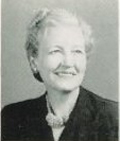 I have to put a word in here about another turning point. That was Ms.
Jennie Jones, who was, especially by today's standards, a very stern and tough
teacher. If we found out at the beginning of the year that we had her, we
panicked. She scared all of us to no end and she had a sign over her door
that said "Fools rush in where angels fear to tread." But, she
had a huge impact on my life. She was forever, by far, my favorite
teacher. "Jennie" was responsible for ingraining so many
important values and attitudes in so many lives. I would wish that each of
our grandchildren might have a "Jennie Jones" to teach them one
year. Some forty years after graduation, I was able to tell that marvelous
teacher at one of the class reunions that she had always been my favorite
teacher, and what an impact she had on so many lives, especially mine.
I have to put a word in here about another turning point. That was Ms.
Jennie Jones, who was, especially by today's standards, a very stern and tough
teacher. If we found out at the beginning of the year that we had her, we
panicked. She scared all of us to no end and she had a sign over her door
that said "Fools rush in where angels fear to tread." But, she
had a huge impact on my life. She was forever, by far, my favorite
teacher. "Jennie" was responsible for ingraining so many
important values and attitudes in so many lives. I would wish that each of
our grandchildren might have a "Jennie Jones" to teach them one
year. Some forty years after graduation, I was able to tell that marvelous
teacher at one of the class reunions that she had always been my favorite
teacher, and what an impact she had on so many lives, especially mine.
 For those of you who know the name "Faron
Young," he was in our choir also. One of his big hits was "Hello
Walls." I was able to go see Faron perform twice, once at Disney World and once
here in Tampa. Faron also thrilled all of us by entertaining us at one of
our class reunions. He was quite the singer and comedian. When he was
performing in Tampa, he invited Chuck and me back to his room at intermission
and he told us the first thing he did when he made the big time was to put
indoor plumbing and a bathroom in his parents' home. He drove Ms. Congdon
around the bend, coming into class late, telling Ms. Congdon that the trolley
had run out of gas, etc. and she was always fussing at him, saying "Young,
you are never going to amount to anything." When we went to see Faron
perform at Disneyworld, we sent a note back to his dressing room that we were
out in the audience. He came on stage, sang a couple of songs and then had
them turn the spotlight on us as he began to reminisce about some of those
incidents from the stage during his show. We lost him in 1996,
unfortunately. Here is a rundown of his life story, that I found
interesting:
For those of you who know the name "Faron
Young," he was in our choir also. One of his big hits was "Hello
Walls." I was able to go see Faron perform twice, once at Disney World and once
here in Tampa. Faron also thrilled all of us by entertaining us at one of
our class reunions. He was quite the singer and comedian. When he was
performing in Tampa, he invited Chuck and me back to his room at intermission
and he told us the first thing he did when he made the big time was to put
indoor plumbing and a bathroom in his parents' home. He drove Ms. Congdon
around the bend, coming into class late, telling Ms. Congdon that the trolley
had run out of gas, etc. and she was always fussing at him, saying "Young,
you are never going to amount to anything." When we went to see Faron
perform at Disneyworld, we sent a note back to his dressing room that we were
out in the audience. He came on stage, sang a couple of songs and then had
them turn the spotlight on us as he began to reminisce about some of those
incidents from the stage during his show. We lost him in 1996,
unfortunately. Here is a rundown of his life story, that I found
interesting:
|
Originally known as "the Hillbilly Heartthrob"
and "the Singing Sheriff,"
Faron Young had one of the longest-running
and most popular careers in country music
history.
Emerging in the early '50s, Young was one of the most popular honky tonkers to appear in the wake of Hank Williams' death, partially because he was able to smooth out some of the grittiest elements of his music. At first, he balanced honky tonk with pop vocal phrasing and flourishes. This combination of grit and polish resulted in a streak of Top Ten hits -- including "If You Ain't Lovin'," "Live Fast, Love Hard, Die Young," "Sweet Dreams," "Alone With You," and "Country Girl" -- that ran throughout the '50s. During the '60s, Young gave himself over to country-pop, and while the hits weren't quite as big, they didn't stop coming until the early '80s. Through that time, he was a staple at the Grand Ole Opry and various television shows, including Nashville Now, and he also founded the major country music magazine, Music City News. Most importantly, he continued to seek out new songwriters -- including Don Gibson, Willie Nelson, and Kris Kristofferson -- thereby cultivating a new generation of talent. Faron Young was born and raised outside of Shreveport, LA. While he was growing up on his father's dairy farm, he was given a guitar, and by the time he entered high school, he had begun singing in a country band. Following high school, he briefly attended college, before he left school to join the Louisiana Hayride as a regular performer. While on the Hayride, he met Webb Pierce and in a short time, the pair were touring throughout the South, singing as a duo in various nightclubs and honky tonks. In 1951, he recorded "Have I Waited Too Long" and "Tattle Tale Tears" for the independent label Gotham. After hearing the singles, Capitol Records decided to buy Young's contract away from Gotham in 1952. That same year, he was invited to perform regularly on the Grand Ole Opry. Just as his career was taking off, Young was drafted into the Army to serve in the Korean War. Assigned to the Special Service division, he sang for the troops in Asia and appeared on recruitment shows; while on leave, he recorded his debut on Capitol, "Goin' Steady." Upon its early 1953 release, it climbed to number two on the country charts and it was followed in the summer by "I Can't Wait (For the Sun to Go Down)," which hit number five. Young was discharged from the Army in November of 1954, releasing "If You Ain't Lovin," his biggest hit, shortly after he returned. The single was quickly followed in the spring of 1955 by "Live Fast, Love Hard, Die Young," which became his first number one hit, and the number two single, "All Right." As soon as he returned to the States, Faron Young began turning out singles at a very rapid pace, and most of them charted in the Top Ten. In addition to recording, he began appearing in films, starting with 1955's Hidden Guns. Over the next few years, he was in no less than ten films -- including Daniel Boone, Road to Nashville, Stampede, A Gun and a Gavel, That's Country, and Raiders of Old California -- and was featured in many television shows. Upon his first film appearance, Faron earned the nickname "the Young Sheriff," which eventually metamorphasized into "the Singing Sheriff." Young's career truly began to hit its stride in 1956, as "I've Got Five Dollars and It's Saturday Night" and "You're Still Mine" reached number four and three, respectively, during the spring, followed by the number two "Sweet Dreams" later that summer. "Sweet Dreams" was not only his biggest hit since "All Right," but it gave songwriter Don Gibson his first significant exposure. Soon, Young developed a reputation for finding promising new songwriters, bringing Roy Drusky's "Alone With You" to the top of the charts in the summer of 1958 and taking Willie Nelson's "Hello Walls" to number one in 1961; Young was one of the first artists to record a Nelson song. Young continued to record for Capitol through 1962, when he switched labels and signed with Mercury. In general, Young's Mercury recordings were more pop-oriented than his Capitol work, possibly because "Hello Walls," his last number one for Capitol, reached number 12 on the pop charts. Throughout the early and mid-'60s, Young's music became more polished and produced, yet his audience didn't decline dramatically; he may not have been hitting every top of the charts with the same frequency as he was during the '50s, but he was still a consistent hitmaker, and singles like "You'll Drive Me Back (Into Her Arms Again)," "Keeping Up With the Joneses," and "Walk Tall" climbed into the Top Ten. Faron left the Grand Ole Opry in 1965, deciding that it was more profitable for him to tour as a solo artist instead of being restricted to the Opry. Following his departure, Young began to explore a number of different business ventures, including a Nashville-based racetrack and helping to run the country music publication Music City News, which he co-founded with Preston Temple in 1963. By the end of the decade, he began to return to honky tonk, most notably with the hit "Wine Me Up," which reached number two upon its summer 1969 release. For nearly five years, Young continued to reach the Top Ten with regularity, including such hits as "Your Time's Comin'," "If I Ever Fall in Love (With a Honky Tonk Girl)," "Step Aside," and "It's Four in the Morning." During this time, Young continued to appear on television shows and he made the occasional appearance on the Grand Ole Opry. During the late '70s, his hits gradually began to fade away. In 1979, he left Mercury for MCA, but none of his singles for the new label reached the Top 40.
During the '90s, Young was stricken with a debilitating emphysema. Depressed by his poor health, he shot himself on December 9, 1996, and passed away the next day. Though he was underappreciated toward the end of his career, Faron Young was a groundbreaking vocalist during the '50s, and he remains one of the finest honky tonkers of his time. ~ Stephen Thomas Erlewine, All Music Guide |




|
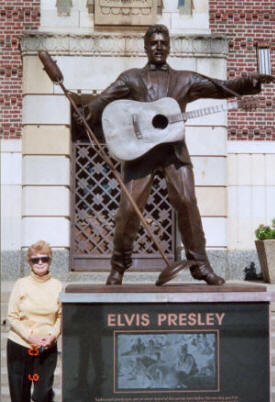
2005 - Shreveport Auditorium-Where Elvis and Faron started out. Jackie standing by Elvis Presley's statue
Legend has it that Elvis sang Blue Moon of Kentucky on a radio station and the DJ recommended that he go to the Louisiana Hayride in Shreveport, LA. He did; it was his first real public appearance and from there, the rest is history.
Thought this map was interesting so I decided to put it on here. For those of you reading this who are not familiar with the part of Louisiana I am from, the blue is it - Caddo Parish, LA.
 |
Please click on the "Next" button below to go to the second page of my life.
